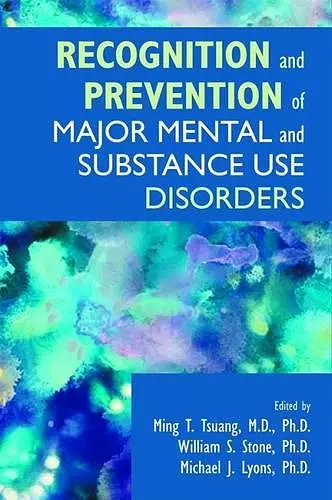Recognition and Prevention of Major Mental and Substance Use Disorders
American Psychopathological Association author William S Stone editor Ming T Tsuang editor Michael J Lyons editor
Format:Hardback
Publisher:American Psychiatric Association Publishing
Published:17th Apr '07
Currently unavailable, and unfortunately no date known when it will be back

Recognizing that favorable clinical outcomes are associated with earlier initiation of treatment—and even more ideally with prevention—this volume addresses the current status of early intervention in, and prevention of, major mental and substance use disorders. A team of distinguished participants addresses this problem at many levels—from the DNA molecule to public policy—in order to show how prevention efforts should be informed by a better understanding of etiology and by a knowledge of indicators of vulnerability.
In considering the current standing of etiological knowledge, Recognition and Prevention of Major Mental and Substance Use Disorders addresses issues that are critical precursors to the prevention of mental disorders and offers an understanding of factors that contribute to the disorders' development. The contributors review genetic methodologies and current findings in mental disorders, with an emphasis on schizophrenia, and then show how biological and psychosocial environmental variables may affect vulnerability. Chapters devoted specifically to lessons in prevention drawn from recent research into schizophrenia discuss the implications of prodromal studies and relationships between stress, critical periods, and the development of the disorder. The book includes contributions from NIH representatives on how basic scientific understanding of mental disorders can be translated into public policy. It also features chapters that describe cutting-edge projects in prevention research for Alzheimer's disease, drug dependence, antisocial behavior, and posttraumatic stress disorder—each providing compelling accounts of how existing knowledge can be adapted to promising prevention efforts. Among the volume's contributions:
• New data on the role of substance abuse—particularly marijuana and psychostimulants—in increasing vulnerability to schizophrenia
• Review of vulnerability factors for several relevant disorders, examining stress and its concomitant psychobiological responses and the contribution of cognitive factors to vulnerability to depression
• Intriguing approach for translating successful treatment methods for schizophrenia into efforts to prevent the transition from the prodrome of the disorder to the full-blown illness
• Program for prevention of antisocial behavior that can be implemented as early as the first grade
• Secondary prevention efforts for posttraumatic stress disorder, with a focus on pharmacological interventions
Each chapter reviews clinical implications of the research presented, contributing to a volume that will benefit clinicians and researchers who share the goal of preventing these debilitating conditions. This multidimensional, interdisciplinary work represents a major step...
I found this to be an intriguing book, helpfully focusing a large body of work that I would not likely other wise have been able to digest. The articles are clearly written, in the main, and with mindfulness of the audience, which includes clinicians not familiar with the details of much of the basic science recounted here. It is a commendably useful text, to be read for its evident importance to our understanding of a critical and expanding area of investigation.
* The American Journal of Psychiatry *Overall, this is a nice review of research into the still young field of prevention in psychiatric illness. The overarching clinical emphasis is on improving outcomes through earlier interventions. The book is probably essential reading for anyone in this field of research, but it provides less practical clinical guidance on the topic than one might desire.
* Doddy Enterprise *Generally speaking, the chapter authors have done a careful job, considering the multiple factors leading to the manifestation of each disorder covered. They take an analytic approach and are conscientious about reporting studies in enough detail to allow the reader to see how changing one contributing factor influenced outcomes. Many of the chapters employ or report the results of meta-analyses in the service of examining patterns of data across studies. They note areas in which the results are consistent and other areas in which consensuses among outcomes has not been reached. The authors are also careful to make distinctions among theories for which data are still being evaluated, and theories with mixed support. More impressive, they accomplish this in a writing style that is engaging.
* PsycnISBN: 9781585623082
Dimensions: 229mm x 152mm x 30mm
Weight: 771g
429 pages